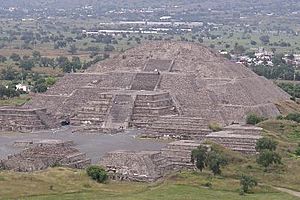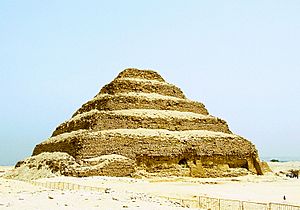Step pyramid facts for kids

Step pyramids are a special type of pyramid that look like huge stairs climbing towards the sky. They are usually very big structures. Many different ancient groups of people, known as civilizations, built them. You can find these amazing step pyramids in places like Egypt, what is now Mexico, and what is now Sudan. They show us how clever and skilled ancient builders were!
Contents
What are Step Pyramids?
A step pyramid is a pyramid built with several layers or "steps." Each step is smaller than the one below it. This design makes the pyramid look like a giant staircase. Unlike the smooth-sided pyramids you might imagine, step pyramids have flat tops on each level.
Who Built These Amazing Structures?
Many ancient civilizations around the world built step pyramids. These include the ancient Egyptians, the Maya people, the Aztecs, and other groups in Mesoamerica (a historical region in North and Central America). They also appear in places like Mesopotamia (modern-day Iraq) and Indonesia.
Famous Step Pyramids Around the World
Step pyramids are found on different continents, each with its own unique history and purpose.
Egyptian Step Pyramids
One of the most famous step pyramids is the Pyramid of Djoser at Saqqara in Ancient Egypt. It was built around 2630 BC for Pharaoh Djoser. This pyramid is considered one of the earliest large stone buildings in the world. It was designed by an architect named Imhotep. The pyramid was part of a huge complex with temples and courtyards.
Mesoamerican Step Pyramids
In what is now Mexico, many step pyramids were built by ancient civilizations like the Maya and Aztecs. These pyramids often served as temples or ceremonial centers.
- The Pyramid of the Sun and Pyramid of the Moon at Teotihuacán are massive step pyramids. Teotihuacán was a huge ancient city near modern-day Mexico City.
- El Castillo at Chichen Itza is a famous Maya step pyramid in Mexico. It has 365 steps, one for each day of the year, showing the Maya's advanced knowledge of astronomy.
Other Notable Step Pyramids
- In Sudan, the ancient Kingdom of Kush also built step pyramids, though they are generally smaller than those in Egypt.
- The Ziggurat of Ur in modern-day Iraq is an ancient step pyramid, or ziggurat, built by the Sumerians over 4,000 years ago. Ziggurats were massive temples built for their gods.
- The Sukuh temple in Indonesia is another example of a step pyramid, showing that this building style appeared in many different cultures.
Why Were They Built?
Ancient people built step pyramids for several important reasons:
- Religious Centers: Many step pyramids were temples dedicated to gods or goddesses. People would climb the steps to reach the top, where rituals and ceremonies took place. They believed the higher the temple, the closer they were to the heavens.
- Tombs: In some cultures, like ancient Egypt, step pyramids were built as grand tombs for pharaohs and important leaders. They were meant to protect the body and treasures of the deceased for the afterlife.
- Observatories: Some pyramids, especially in Mesoamerica, were also used to study the stars and planets. Their precise alignment with celestial events helped ancient astronomers track time and seasons.
- Symbols of Power: Building such massive structures required a lot of people, resources, and organization. Pyramids showed the power and wealth of the rulers and their civilizations.
How Were They Built?
Building these huge structures was an incredible feat without modern machinery. Ancient builders used simple tools and a lot of human effort.
- They often used local materials like stone, mud bricks, or earth.
- Workers would cut and shape large blocks of stone.
- They then moved these heavy blocks using ramps, ropes, and sleds.
- Thousands of workers would labor for many years, sometimes even decades, to complete a single pyramid.
The precise way they moved and placed the massive stones still amazes engineers and historians today!
Images for kids
-
Stepped pyramids in Teotihuacan, Mexico
-
The 4100-year-old Great Ziggurat of Ur in southern Iraq
-
Pyramid of Djoser in 2010
-
El Castillo, Chichen Itza, Mexico
See also
 In Spanish: Pirámide escalonada para niños
In Spanish: Pirámide escalonada para niños









